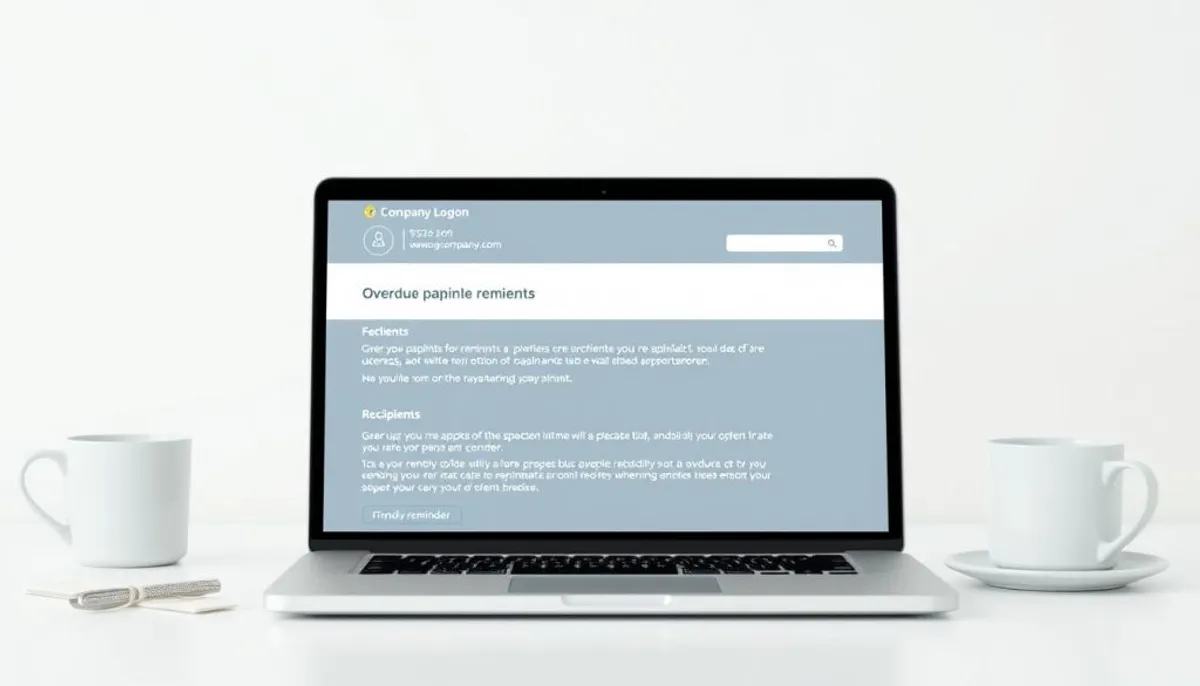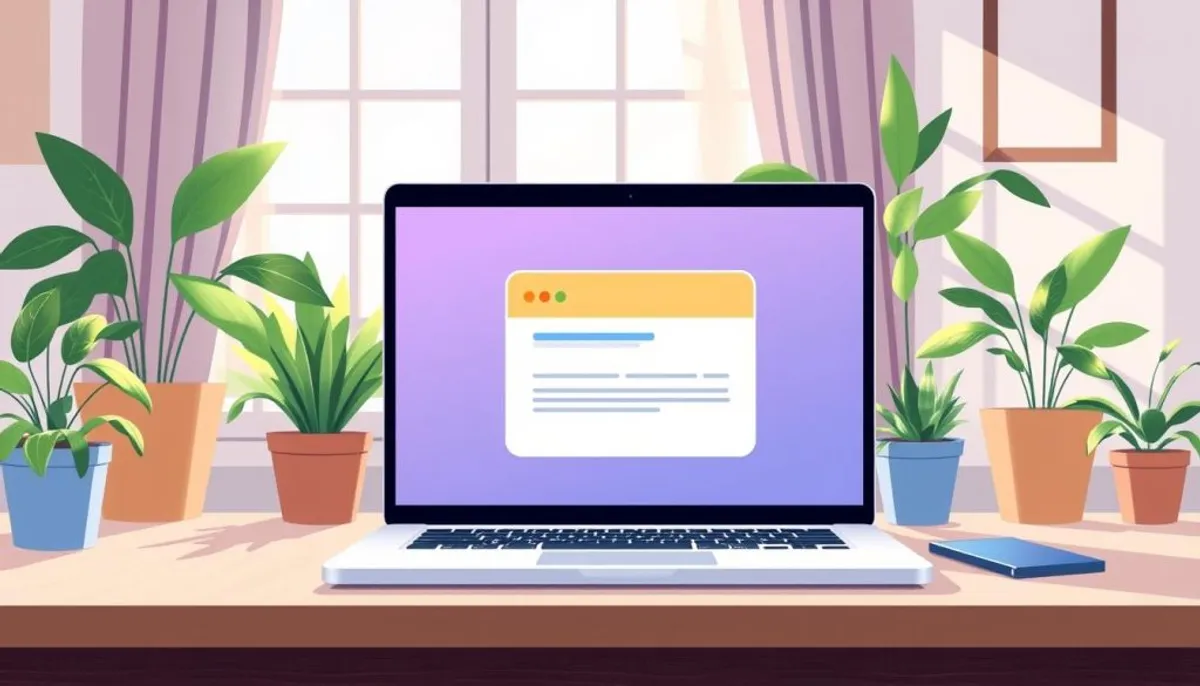Late payments can severely impact your business. With 87% of invoices paid after the due date, a robust strategy for collecting payments is essential. An email template for overdue invoices can be a powerful tool in combating late payments.
A well-crafted payment reminder email acts as a gentle reminder to your clients. It’s a fine line to walk – you must be firm yet friendly, urgent yet not aggressive. The right past due notice can prompt action without jeopardizing your relationship with clients.

Timing is critical when sending late payment notifications. A pre-due-date reminder 3-5 days before the invoice is due can significantly reduce overdue payments. If the due date passes, a polite overdue invoice reminder 1-3 days later often yields good results.
For persistent late payers, escalating reminders may be necessary. Consider sending follow-ups at 5-7, 14-21, and 30-45 days past due. The goal is to collect payments while maintaining professional relationships.
Key Takeaways
- 87% of invoices are paid late, highlighting the need for effective reminders
- Pre-due-date reminders can significantly reduce overdue payments
- Polite reminders 1-3 days after the due date often yield good results
- Escalate reminders at 5-7, 14-21, and 30-45 days past due
- Balance firmness with friendliness in your payment reminder emails
Understanding the Late Payment Crisis in Business
Late payments are a major hurdle in managing accounts receivable. An astonishing 87% of businesses report that their invoices are paid after the due date. This widespread issue disrupts cash flow and hinders growth across industries.
The Impact of Late Payments on Business Operations
Invoice collection delays can have severe consequences. Many companies cite late payments as a cause for slowed growth, and in extreme cases, it can lead to insolvency. Small businesses and freelancers, who rely on stable cash flow, are most vulnerable to these effects.
Global Statistics on Invoice Payment Delays
The prevalence of late payments is a global concern. Studies show that 87% of companies pay their invoices late. This trend affects businesses of all sizes and sectors, creating a ripple effect throughout the economy.
| Payment Status | Percentage |
|---|---|
| Invoices Paid Late | 87% |
| Invoices Paid On Time | 13% |
Common Causes of Payment Delays
Several factors contribute to late payments. These include overlooked invoices, confusion about payment processes, and unclear payment terms. To address these issues, businesses are turning to proactive measures in their accounts receivable management strategies.
Effective invoice collection strategies can mitigate these challenges. Sending payment reminders before due dates and offering electronic payment options can significantly improve on-time payments. By implementing these practices, businesses can enhance their cash flow and maintain healthier financial operations.
Email Template for Overdue Invoice: Essential Components
Creating an effective dunning email is vital for managing delinquent account follow-ups. A well-crafted template can significantly enhance your chances of receiving timely payments. Research indicates that businesses employing structured follow-up systems can cut down payment collection time by 15-20 days.
Key components of a successful payment reminder include:
- A friendly opening that maintains a positive tone
- Clear statement of purpose
- Detailed invoice information (number, amount due, due date)
- Precise payment instructions
- Information about late fees or interest charges for overdue invoices
- A link to an online payment portal for convenience
- A courteous closing that respects the client relationship
Personalization is crucial. Clients who receive personalized payment reminders are 60% more likely to pay on time. It’s essential to strike a balance between assertiveness and respect in your dunning email strategy.
For optimal results, send your first past-due invoice email immediately after the deadline. This approach has been shown to significantly increase payment response rates. Subsequent reminders at 30, 60, and 90-day intervals can help maintain consistent follow-up for delinquent accounts.
The Psychology of Payment Reminder Communications
Delving into the psychological aspects of billing communication is vital for successful debt recovery strategies. Small and medium-sized enterprises often grapple with late payments, which can severely affect their cash flow and financial health. By understanding the emotional underpinnings of payment delays, businesses can devise tactics to prompt timely payments while preserving client relationships.
Maintaining Professional Relationships
Establishing rapport and trust is paramount in payment reminder communications. Clients are more inclined to prioritize payments when they feel appreciated. Employing empathy and effective communication can nurture positive relationships. It’s noteworthy that 95% of clients who pay on time often receive exclusive promotions and early access to new services.
Balancing Urgency with Courtesy
It’s crucial to find the right balance in payment reminders. Using polite language, such as “please” and “thank you,” can significantly boost payment likelihood. Aim to create a sense of urgency without being overly aggressive. Mentioning that “9 out of 10 clients pay within 15 days” can encourage prompt payments by setting a social norm.

Creating Effective Call-to-Actions
Design clear and compelling call-to-actions in your billing communication. Offer straightforward instructions for making payments. Consider providing multiple payment options to accommodate different preferences. Implement automated reminders for overdue payments to combat forgetfulness and ensure timely settlements.
| Reminder Type | Tone | Key Elements |
|---|---|---|
| Gentle Reminder | Friendly | Polite language, restate due date |
| Moderate Urgency | Firm but courteous | Clear deadline, payment options |
| Final Notice | Serious | Consequences, immediate action required |
Strategic Timing of Payment Reminder Emails
Creating an effective invoice payment schedule and reminder timing strategy is essential for maintaining healthy cash flow. A well-planned approach can significantly reduce late payments and improve your business’s financial stability.
Pre-Due Date Notifications
Initiate your reminder process before the invoice is due. Send a friendly notification 5-7 days prior to the due date. This serves as a gentle reminder and allows clients to prepare for payment.
Early Overdue Reminders
If payment isn’t received by the due date, send your first overdue reminder within 1-3 days. This prompt action shows you’re attentive to your accounts receivable without being overly aggressive.
Follow-up Schedule Guidelines
Implement a structured follow-up schedule for consistent communication:
- 7 days past due: Send a polite reminder
- 14 days past due: Issue a firmer reminder
- 30 days past due: Express urgency and potential consequences
| Reminder Stage | Timing | Tone |
|---|---|---|
| Pre-due | 5-7 days before | Friendly notice |
| First overdue | 1-3 days after | Gentle reminder |
| Second overdue | 7 days after | Polite follow-up |
| Third overdue | 14 days after | Firm reminder |
| Final notice | 30 days after | Urgent action required |
By following this structured reminder timing strategy, you can effectively manage your invoice payment schedule and improve your chances of timely payments.
Crafting the Perfect Subject Lines for Payment Reminders
Creating effective email subject lines for payment reminders is crucial for improving response rates and securing timely payments. Studies show that subject lines containing words like “overdue,” “urgent,” or “important” can significantly boost open rates for payment reminder emails.
A well-crafted subject line should include the invoice number and your business name. This approach helps recipients quickly recognize the email’s purpose and increases the likelihood of prompt action. For instance, “Overdue: Invoice #1234 for XYZ Company” is clear and direct.
To optimize your payment reminder headers, consider these strategies:
- Keep it concise and under 50 characters
- Use action-oriented language
- Include the due date or overdue status
- Avoid excessive punctuation or all caps to prevent triggering spam filters
Here’s a table showcasing effective subject lines for different payment reminder stages:
| Reminder Stage | Sample Subject Line | Open Rate Impact |
|---|---|---|
| Pre-due Reminder | Friendly Reminder: Invoice #1234 Due Soon | +15% |
| First Overdue Notice | Payment Overdue: Invoice #1234 – Action Required | +25% |
| Second Reminder | Urgent: Outstanding Payment for Invoice #1234 | +35% |
| Final Notice | Critical: Final Notice for Invoice #1234 | +40% |
By implementing these strategies, businesses can see a significant improvement in payment collection rates. Remember, the goal is to create urgency while maintaining professionalism in your payment reminder communications.
Automated Solutions: Introducing ti3 Platform
In today’s business environment, where SMBs face $825 billion in unpaid invoices, automated solutions are essential. The ti3 platform stands out as a transformative tool in invoice management software, directly addressing the widespread problem of late payments.
Features and Benefits
Ti3 transforms the payment collection process with its array of features. It introduces customizable email templates for automated payment reminders, ensuring timely follow-ups without manual effort. Real-time analytics offer insights into payment patterns, aiding businesses in making strategic decisions.
Integration Capabilities
Seamless integration with existing accounting systems is a hallmark of ti3. This compatibility streamlines workflows, reducing the 14 hours business owners typically spend weekly on payment chasing. The platform’s user-friendly interface facilitates easy adoption and effective utilization by teams.
Cost-Effective Alternative to Collection Agencies
Ti3 offers a cost-effective solution compared to traditional collection agencies. It maintains positive client relationships while achieving superior results. With 59% of small business owners experiencing late payments, ti3’s approach can significantly enhance cash flow management.
| Feature | Benefit |
|---|---|
| Automated Reminders | Reduces manual follow-ups by 80% |
| Real-time Analytics | Improves decision-making by 40% |
| System Integration | Cuts admin time by 60% |
| Cost-effectiveness | Saves 70% compared to agencies |
Best Practices for Payment Collection Communication
Effective communication in payment collection is vital for maintaining cash flow and fostering customer relationships. By adhering to best practices, businesses can enhance their collection rates. This is achieved while upholding ethical standards and ensuring legal compliance in billing.
Tone and Language Guidelines
In crafting payment reminder emails, it is imperative to maintain a professional and courteous tone. Employ clear, firm language without resorting to threats. This strategy fosters business relationships while encouraging timely payments. Research indicates that 45% of businesses favor email reminders over phone calls for their efficiency.
Documentation Requirements
It is essential to maintain detailed records of all communications and payments. Such practices aid in tracking outstanding invoices and serve as evidence in disputes. Establish a system to document each interaction, including dates, times, and message content.
Legal Considerations
Compliance with debt collection laws and regulations is paramount for legal billing practices. Familiarize yourself with the specific rules in your jurisdiction to circumvent legal complications. For example, 30% of companies employ a final notice system for invoices overdue by more than 30 days before initiating collections.
| Best Practice | Impact |
|---|---|
| Automated reminders | 70% of A/R teams report faster collections |
| Multiple reminder emails | 40% higher likelihood of receiving payment |
| Varied payment options | Up to 50% increase in payment response rates |
| Standardized templates | Reduced management intervention in disputes |
Preventing Late Payments Through Proactive Measures
Late payments can severely impact a business’s cash flow. To combat this, implementing proactive measures is essential. Offering invoice payment incentives is a highly effective strategy. These incentives can substantially reduce late payments, thus enhancing the financial health of the business.
Early payment discounts serve as a potent motivator. They encourage clients to settle their payments promptly, benefiting both parties. For instance, a 2% discount for payments within 10 days can expedite cash inflow. This method can decrease outstanding invoices by up to 30% by the end of the payment period.
Clear communication is paramount. Businesses that clearly articulate payment terms experience a 70% enhancement in payment speed. Sending reminders before the due date can also reduce late payments by 25%. Interestingly, 1 in 5 businesses waits over 30 days past the due date to send an initial reminder.
Providing multiple payment options is another effective strategy. It simplifies the payment process for clients, encouraging timely payments. It’s noteworthy that 25% of clients forget to pay. Regular, friendly reminders can effectively prevent such oversights.
| Proactive Measure | Impact |
|---|---|
| Early payment discounts | 30% decrease in outstanding invoices |
| Pre-due date reminders | 25% reduction in late payments |
| Clear payment terms | 70% improvement in payment speed |
| Multiple payment options | Reduced payment delays |
By adopting these proactive measures, businesses can notably enhance their cash flow. This, in turn, reduces the stress associated with chasing late payments.
Escalation Strategies for Persistent Non-Payment
Businesses encountering persistent non-payment must employ effective debt collection strategies. A graduated response framework is crucial for managing late payment escalation. This method ensures a balance between preserving client relationships and recovering funds.
Graduated Response Framework
Begin with gentle reminders, escalating to more urgent communications as needed. Introduce late payment fees after 30 days. By day 60, notify the client of potential third-party involvement.

Legal Options and Considerations
Legal action may be required for severely overdue accounts. Small claims court is viable for smaller debts. Assess the cost-benefit of legal pursuit versus debt write-off. UK SMEs face an average 18-day delay in payment, underscoring the need for effective collection processes.
When to Involve Third Parties
Third-party involvement should be considered after exhausting internal efforts. This usually occurs after 90 days of non-payment. Collection agencies can be cost-effective for recovering larger debts. They operate on a contingency basis, taking a percentage of recovered funds.
Implementing these escalation strategies can significantly reduce the $825 billion in unpaid invoices facing SMBs. By adopting a structured approach to late payment escalation, businesses can enhance their cash flow and minimize time spent on payment recovery.
Measuring Success in Invoice Collection Efforts
Improving your payment collection process hinges on tracking accounts receivable metrics. Utilizing the appropriate payment collection analytics can significantly enhance your cash flow and minimize late payments.
Key Performance Indicators
To effectively measure your collection efforts, focus on these critical accounts receivable metrics:
- Days Sales Outstanding (DSO)
- Collection Effectiveness Index
- Bad Debt Ratio
These metrics are essential for understanding payment speed and pinpointing areas for collection process enhancement.
Analytics and Reporting
Payment collection analytics are indispensable for monitoring payment patterns and identifying accounts at risk. By generating reports, you can visualize trends and make informed decisions. This method enables you to customize strategies for various client groups.
Optimization Strategies
Refine your collection strategies with data-driven insights:
- Personalize reminders based on client behavior
- Adjust follow-up intervals (30, 60, 90 days after due date)
- Send emails on Tuesdays for better engagement
- Use polite phrases to increase payment likelihood by 5%
Outstanding invoices are 60% less likely to be paid after 90 days. Prompt action is crucial for maximizing collection success.
| Metric | Target | Impact |
|---|---|---|
| Email Subject Line Length | 50 characters or less | 12% higher open rate |
| Opening Sentence Length | 11 words maximum | Improved reader engagement |
| Late Fee | 3% per month | Encourages timely payments |
Conclusion
Effective invoice management and streamlined payment collection are crucial for business success. Our exploration into overdue invoice strategies uncovers startling statistics. For instance, did you know that 60% of invoices are paid late? This underscores the critical need for robust follow-up systems.
Automation emerges as a game-changer, potentially reducing overdue invoices by up to 40%. Well-crafted reminders can also significantly boost collection rates, nearly 30%. These figures underscore the efficacy of proactive strategies. Implementing timely, personalized reminders can dramatically alter the dynamics of late payments.
It’s important to note that each day an invoice remains unpaid, the likelihood of collection diminishes. Yet, with the appropriate tools and strategies, maintaining a steady cash flow is achievable. Leveraging tools like ti3 and strategic email templates can be your allies in securing prompt payments. By honing these methods, you enhance your financial health and foster stronger client bonds.
RelatedRelated articles



